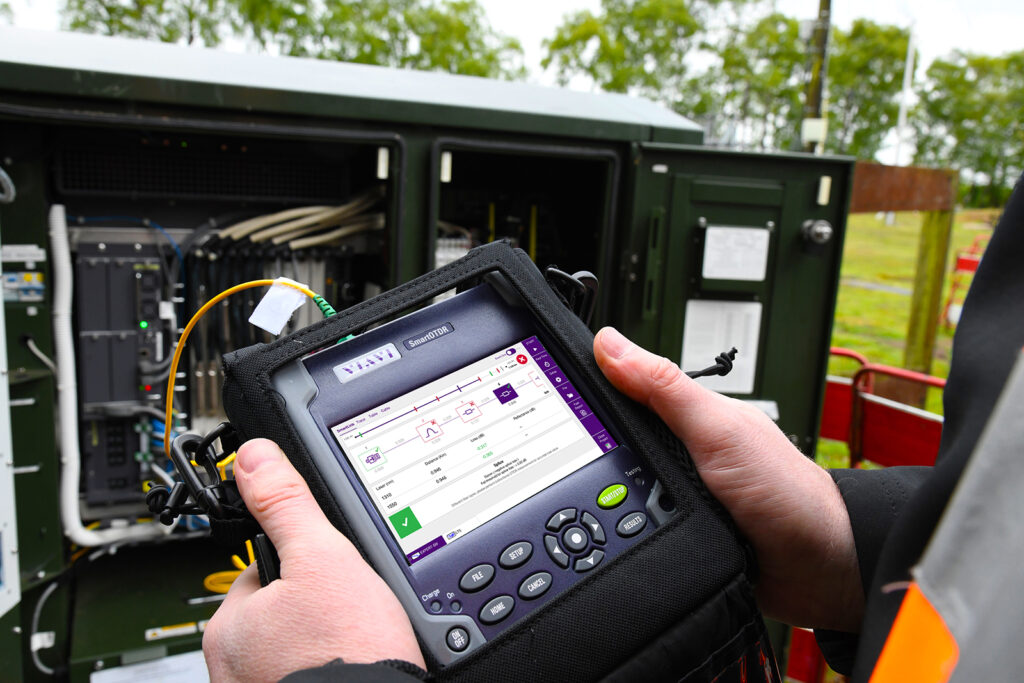The development, certification, maintenance, and troubleshooting of fiber optic systems now require the use of OTDR testers in the USA techniques due to the rapid improvements in fiber optic technology and the deployment of new fiber networks.
The processed data can reveal details about the state and functionality of the fibers as well as any passive optical parts found in the cable’s path, such as splitters, connectors, and multiplexers.
Once this data has been gathered, examined, and stored, it can be accessed whenever necessary to continue to assess the same cable.
How Does OTDR Function?
An optical fiber’s one end receives a pulse of laser-generated light energy (optical power) from the OTDR. The optical power or returning light energy is measured over time by a photodiode, which then transforms it into an electrical value that may be sampled, amplified, and visually displayed on a screen.
The proportionate amplitude change of the backscattered light is used to compute the insertion loss. By transmitting test pulses, many contemporary OTDR testers in the USA automatically choose the best acquisition parameters for a specific fiber, a procedure known as auto-configuration, auto setup, or auto test.
OTDR Testing Comparison
As communication networks migrated to fiber optics, there are clear parallels between OTDR testers in the USA and the copper wire signal testing it gradually replaced. Another helpful comparison involves ultrasound technology.
The vibrating components of an ultrasound transducer emit high frequency (20 KHZ) inaudible sound waves, which are then reflected back to the source to produce precise images of physiological features in medical imaging applications. Similar to this, the OTDR’s light waves that are reflected or dispersed enable for the “sighting” of the fiber core’s general state.
Best Practices for OTDR
Fiber cleaning and inspection procedures are crucial before reference cables and the fiber being tested are connected for measurement.
To reduce reflection, launch cables, the fiber being tested, and the OTDR’s mating connections must be compatible. Imagine a hose bib that is connected to the hose improperly or loosely, resulting in water leakage and backflow from the junction. This is comparable to how a bad OTDR connection affects the photodiode by allowing too much light to be reflected back through air gaps.
Specifications of OTDR
Understanding OTDR specs is crucial for selecting the best OTDR for a particular application:
- Dynamic spectrum:
The robust range, measured in decibels, is the difference between the initial power level reflected from the fiber at maximum oscillation width and the upper level of the sensor’s noise floor. The maximum length of a fiber that can be observed depends on the dynamic range.
- A fading dead zone:
The least distance following a reflecting (such as a connection) or attenuating (such as a splice) event, where a non-reflective event (such as a splice) can be observed, is known as the attenuation dead zone (ADZ) and is described in the IEC 61745 standard.
- Wavelengths:
When the fiber link is operational, OTDR testers in the USA transmit a pulse of light based on the wavelength(s) used for transmission. To prevent interference with the wavelength used for live traffic, preservation can be performed using filtered 1625 nm or 1650 nm.
Equipment Calibration for OTDR Tests
To measure, correct, and reset operations based on reference standards for any measurement equipment, recurrent calibration is required. The TIA/EIA-455-226 standard and the IEC 61746 standard for adjustment are recognized in businesses where precision of OTDR test findings is crucial.
Specific procedures for graduating point-to-point accuracy, linearity, abrasion, power output, and delay are all included in the IEC standard. Given its complexity, OTDR calibration is best left in the hands of the companies who make the equipment or accredited calibration labs.
Problem-Solving with an OTDR
OTDRs are also utilized to analyze the performance of fiber plants. The OTDR testers in the USA can map the cabling, show termination quality, and pinpoint the location of defects that could impair network performance. An OTDR enables the identification of problems throughout a channel’s length that could influence long-term dependability.
Segment length, the location and insertion loss of connections and splices, as well as other occurrences like severe bends that may have occurred during or after cable installation, are all characteristics that OTDR testers in the USA may identify. Newer systems, such 100BASE-DR, additionally have restrictions on the amount of reflectance for each link connector, which can only be checked using an OTDR.
Our Range of OTDR Products
At GE-Equipment, we provide various OTDR products from various well-known companies. For OTDR safety, effectiveness, and test product quality, VIAVI, an industry-leading OTDR producer, is developing new OTDR technology.
Anritsu’s extensive line of OTDR testers in the USA offers a distinctive selection of handheld, benchtop, and OEM module solutions to provide quick and extremely precise measurements of optical fiber cables.
For the OTDR to be a multifunctional fiber tester for use in the field by fiber network specialists, GAOTek integrates additional functionalities like visual fault locators, fiber microscopes, and more.
Why GE-Equipment for your OTDR Testers?
We at Greenway Enterprise provide a wide selection of high-quality OTDR testers in the USA to our customers. Get premium OTDR testers of the highest quality by getting in touch with us right away!
FAQs
What are some best quality OTDR products?
Some of the best quality OTDR products include:
- FF-980MAS (Enhanced OTDR, 12-in-1).
- FF-980EXT (new Enhanced OTDR, 9-in-1).
- High Accuracy OTDR 8000MAX 990PRO (Standard OTDR, Splitter OTDR for Choice).
Where is OTDR used?
A tool called an optical time domain reflectometer (OTDR) is used to construct, certify, maintain, and troubleshoot fiber optic networks. It checks the integrity of a fiber cable.
What distinguishes the OTDR from the OLTS?
While the OLTS is made to measure power and insertion loss precisely, the OTDR is a more advanced tool that is used to analyze an optical fiber in greater detail. A fiber cable’s performance can be verified using both the OTDR and the OLTS, albeit to differing degrees and capacities.

